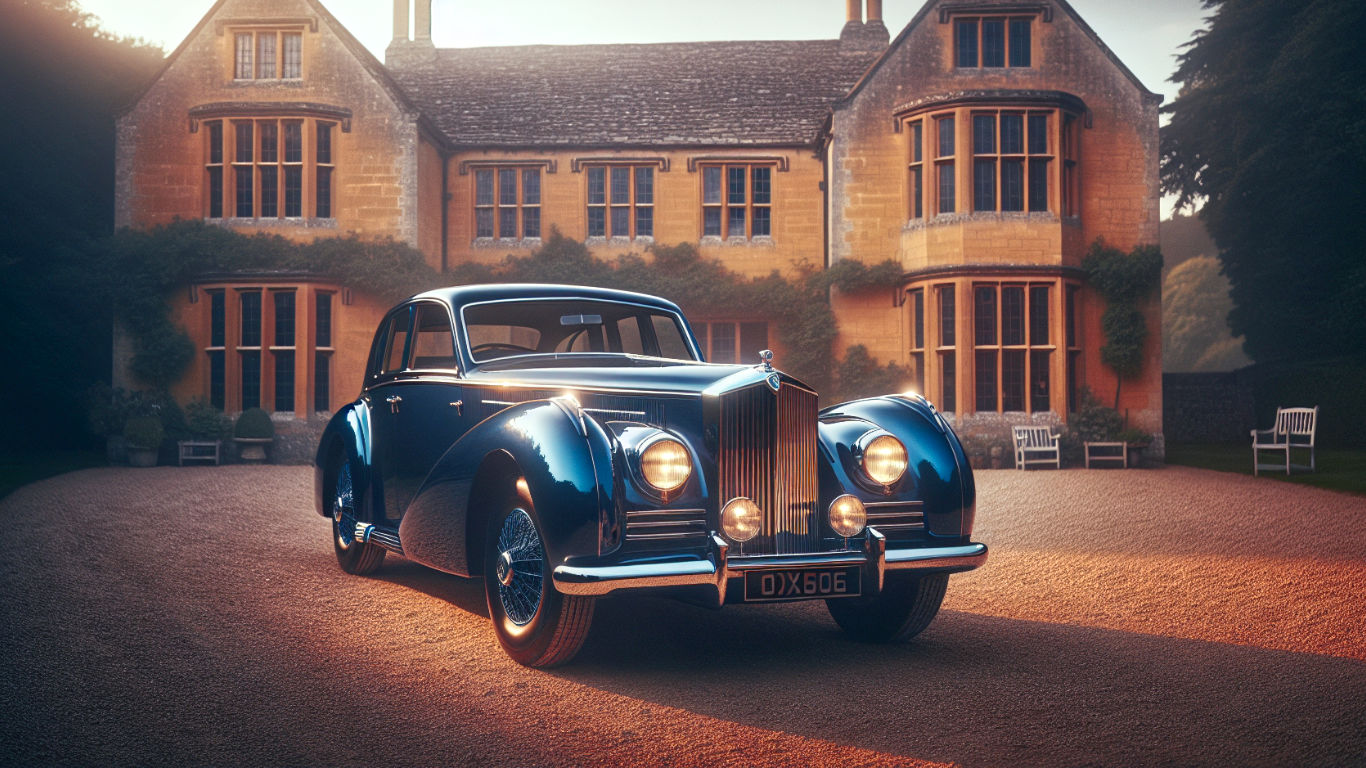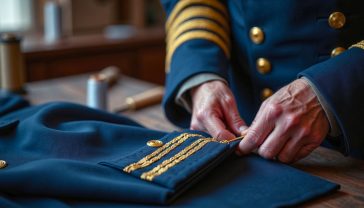The Spirit of Perfection: How Rolls-Royce Became Britain’s Ultimate Symbol of Luxury
Explore the definitive story of Rolls-Royce, Britain’s ultimate symbol of luxury, engineering excellence, and the relentless pursuit of perfection for over a century.

This post may contain affiliate links. If you make a purchase through these links, we may earn a commission at no additional cost to you.
If you were to ask anyone, from a London cabbie to a lord in his country manor, to name the most luxurious car in the world, you’d likely get the same answer: Rolls-Royce. It’s more than just a car; it’s a statement. It’s the quiet, confident embodiment of British excellence, a name whispered with a sense of awe. For over a century, these magnificent machines have been the transport of choice for royalty, rock stars, and titans of industry.
But how did Rolls-Royce become the undisputed king of luxury? It wasn’t just about building expensive cars. It was about a relentless, almost obsessive, pursuit of perfection. It’s a story of a daredevil aristocrat and a brilliant, meticulous engineer who, in 1904, joined forces with a simple handshake and a shared vision: to create “the best car in the world.” This isn’t just a tale of polished chrome and sumptuous leather; it’s a journey through British history, a masterclass in engineering, and a testament to a brand that has refused to compromise, even when the world around it was changing at breakneck speed. From the silent glide of the iconic Silver Ghost to the futuristic hum of its first all-electric Spectre, the story of Rolls-Royce is the story of Britain at its finest.
The Meeting of Two Minds: How It All Began
The tale of Rolls-Royce starts not in a grand factory, but with two very different men from opposite ends of the British class spectrum. Their partnership was unlikely, yet it created a legacy that would define automotive perfection.
Charles Rolls: The Posh Pioneer
The Honourable Charles Stewart Rolls was the very definition of an Edwardian adventurer. Born into immense wealth as the son of a baron, he had every advantage life could offer. Educated at Eton and Cambridge, he was a daredevil with a passion for anything that moved fast. He was a pioneering motorist, a decorated balloonist, and later, one of Britain’s first aviators.
In London, he set up one of the country’s first car dealerships, C.S. Rolls & Co., on Fulham Road. He sold the best cars he could find, mostly imported from France and Belgium. But Charles, a proud Brit, was frustrated. He couldn’t find a British car that met his high standards of quality and reliability. He yearned for a multi-cylinder machine that was quiet, smooth, and dependable—a car that didn’t rattle its occupants to bits on the bumpy roads of the early 20th century.
Henry Royce: The Working-Class Genius
While Rolls was racing cars and flying balloons, Frederick Henry Royce was taking a very different path. Born into poverty, Royce started working at the age of nine after his father’s milling business failed. He sold newspapers for W.H. Smith and delivered telegrams for the Post Office. His formal education was minimal, but his mind was brilliant.
Through sheer grit and an insatiable curiosity for how things worked, he landed an apprenticeship with the Great Northern Railway. He was fascinated by electricity, a new and magical force at the time. By 1884, with just £20 in his pocket, he started his own engineering firm in Manchester, F.H. Royce & Company, making small electrical items like doorbells and dynamos. His reputation for quality grew, and soon he was making powerful industrial cranes.
In 1901, Royce bought his first car, a French Decauville. He was utterly unimpressed. It was noisy, unreliable, and poorly made. Being the perfectionist he was, Royce decided he could do better. He didn’t just want to improve the Decauville; he wanted to reinvent it. He took it apart in his workshop and, piece by piece, began to build his own car. He didn’t just copy the parts; he re-engineered them, making them stronger, simpler, and more reliable. By 1904, he had built three two-cylinder, 10-horsepower “Royce” cars.
The Fateful Handshake at the Midland Hotel
A friend of Charles Rolls, Henry Edmunds, had seen one of Royce’s new cars and was blown away by its quality and quietness. He knew this was exactly what Rolls had been looking for. He arranged a meeting.
On 4th May 1904, Charles Rolls travelled to Manchester and met Henry Royce at the Midland Hotel. Royce, a humble, intense man, showed Rolls his creation. Rolls was sceptical at first, but a short drive was all it took. He was astonished. The car was smooth, quiet, and engineered with a precision he had never seen before. He returned to the hotel and declared, “I have found the greatest motor engineer in the world.”
In that historic meeting, they struck a deal. Rolls would sell every car that Royce could build. The official partnership was formalised in December 1904, and the iconic hyphenated brand was born. A daredevil salesman and a perfectionist engineer had united to chase a single, audacious goal: to build the best car on the planet.
The Pursuit of Perfection: Creating “The Best Car in the World”
The early years of Rolls-Royce were defined by one simple, unwavering principle, famously articulated by Henry Royce: “Strive for perfection in everything you do. Take the best that exists and make it better. When it does not exist, design it.” This wasn’t just a catchy slogan; it was the company’s DNA.
The Silver Ghost: The Car That Cemented a Legend
After producing a handful of early models, Rolls-Royce unveiled the car that would make its name immortal: the 40/50 H.P. chassis, later known as the Silver Ghost. Launched in 1907, it was a masterpiece of engineering. Its six-cylinder engine was so perfectly balanced and quiet that it was said you could balance a penny on its edge while the engine was running.
To prove its unparalleled reliability, Rolls-Royce entered the twelfth 40/50 H.P. chassis, painted a distinctive silver and named the “Silver Ghost,” into the gruelling 1907 Scottish Reliability Trials. The car performed flawlessly. Immediately after, it embarked on an even more ambitious challenge: to drive almost 15,000 miles continuously, with only routine maintenance. The Silver Ghost completed the run without a single involuntary stop, a feat unheard of at the time.
The press went wild. The Autocar magazine dubbed it “the best car in the world,” and the name stuck. The Silver Ghost’s legendary performance established Rolls-Royce’s reputation for three core qualities that define it to this day: reliability, silence, and smoothness. It was so successful that the company produced the chassis for nearly 20 years.
The Icons of Excellence: Spirit of Ecstasy and the Pantheon Grille
Every Rolls-Royce is instantly recognisable, thanks to two enduring symbols of its prestige.
The Spirit of Ecstasy
The elegant figurine of a woman leaning into the wind, her robes billowing behind her like wings, is perhaps the most famous bonnet ornament in the world. She is officially called The Spirit of Ecstasy.
Her story began with an early motoring enthusiast, Lord Montagu of Beaulieu. He commissioned his friend, the sculptor Charles Sykes, to create a personal mascot for his 1909 Silver Ghost. The model for the figurine was Eleanor Thornton, Lord Montagu’s secretary and mistress. The original statuette, nicknamed “The Whisper,” depicted Eleanor with a finger to her lips, symbolising their secret love affair.
Rolls-Royce’s managing director, Claude Johnson, saw that many owners were putting all sorts of inappropriate mascots on their cars. Worried it would damage the brand’s sophisticated image, he commissioned Sykes to create an official mascot that captured the essence of the car: speed, silence, and grace. Sykes subtly modified his original “Whisper” design, and The Spirit of Ecstasy was born in 1911. She has graced the bonnet of almost every Rolls-Royce since, a timeless symbol of beauty and perfection.
The Pantheon Grille
The other unmistakable feature is the iconic grille. Inspired by the classical proportions of the Parthenon in Athens, its shape has remained remarkably consistent for over a century. Henry Royce himself designed it, insisting on its perfect visual balance. Each grille is still assembled and polished by hand, a process that takes an entire day. The vanes are carefully set by eye; no measuring instruments are used. The craftsman simply ensures it looks “right.” This dedication to human skill over automation is central to the Rolls-Royce philosophy.
From the Battlefield to the Jet Age: Rolls-Royce Beyond Cars
While the cars brought fame, it was another area of engineering that secured the company’s future and played a vital role in British history: aero engines.
Powering the Allies: The Merlin Engine
When the First World War broke out, the British government needed powerful and reliable engines for its fighter planes. Rolls-Royce answered the call, developing the Eagle engine, which powered the first-ever direct transatlantic flight in 1919.
This laid the groundwork for what would become the company’s most famous creation: the Rolls-Royce Merlin. Developed in the 1930s, this V12 liquid-cooled piston engine was a marvel of engineering. It was the Merlin that powered two of the most iconic aircraft of the Second World War: the Supermarine Spitfire and the Hawker Hurricane.
The Merlin’s power, reliability, and high-altitude performance gave British pilots a crucial advantage during the Battle of Britain. It’s no exaggeration to say that the roar of the Merlin engine was the sound of Britain’s defiance and, ultimately, its survival. The company’s factory in Derby worked around the clock, becoming a prime target for enemy bombing but never faltering in its mission. Henry Royce’s pursuit of engineering perfection had given Britain the power it needed to defend the skies.
Pioneering the Jet Age
Even before the war ended, Rolls-Royce was looking to the future. It took the pioneering jet engine designs of Sir Frank Whittle and developed them into commercially viable products. Engines like the Avon and the Dart powered Britain’s first generation of jet airliners and military aircraft.
This diversification was crucial. By the mid-20th century, the aerospace division had become the financial backbone of the company, a world leader in jet engine technology. It was this success that allowed the car division to continue its no-compromise approach to luxury, even when building cars by hand was becoming an economic absurdity.
The Modern Era: Navigating Change and Redefining Luxury
The post-war years brought immense social and economic change. For a brand so deeply rooted in tradition, adapting was a major challenge.
A Difficult Period: Bankruptcy and Separation
Despite the success of its jet engines, Rolls-Royce faced a major crisis in the late 1960s. The development costs of a new, advanced engine, the RB211, spiralled out of control. The project was too big and too complex, pushing the entire company to the brink.
In 1971, Rolls-Royce was declared bankrupt. It was a national shock. The British government, recognising the strategic importance of the aerospace and defence division, stepped in and nationalised the company to save it from collapse.
To salvage the business, it was split in two. Rolls-Royce plc became the state-owned aerospace company. The profitable but smaller car division was floated as a separate business, Rolls-Royce Motors, in 1973. For the first time, the car and aero engine businesses were completely independent entities.
New Ownership, New Beginnings
Rolls-Royce Motors continued to produce iconic cars like the Silver Shadow and the Corniche, but it faced stiff competition. In 1980, it was acquired by the engineering conglomerate Vickers. Then, in one of the most complex and dramatic corporate battles of the 1990s, the brand found itself at the centre of a bidding war between two German giants: BMW and Volkswagen.
In a bizarre twist, VW ended up owning the historic Rolls-Royce factory in Crewe and the rights to the Spirit of Ecstasy and the grille shape. However, BMW, which had been supplying engines to Rolls-Royce, managed to secure the rights to the Rolls-Royce name and logo.
This led to an extraordinary gentlemen’s agreement. From 1998 to the end of 2002, BMW would continue to supply parts while VW built the cars. Then, on 1st January 2003, the two would officially part ways. VW would keep the Crewe factory to build Bentleys (which it also owned), and BMW would take the Rolls-Royce name and start afresh.
The Goodwood Era: A British Brand Reborn
BMW’s ownership marked a new chapter. A brand-new, state-of-the-art headquarters and manufacturing plant was built on the Goodwood Estate in Sussex, the heart of the English countryside. This wasn’t just a factory; it was called the “Home of Rolls-Royce,” designed to blend seamlessly into the landscape.
The first car to emerge from Goodwood was the Phantom in 2003. It was a stunning statement of intent. While it used German engineering expertise from its parent company, the Phantom was unmistakably British in its design, craftsmanship, and sense of occasion. It was a triumph, silencing critics and proving that the spirit of Rolls-Royce was alive and well.
Since then, the Goodwood era has seen the brand flourish with models like the Ghost, the Wraith, the Dawn, and its first-ever SUV, the Cullinan. Each car is built to order, with customers able to personalise almost every detail through the company’s “Bespoke” programme.
The Art of Craft: How a Rolls-Royce Is Made
What truly sets a Rolls-Royce apart is the human touch. While it uses modern technology, the majority of the car is assembled by hand by skilled artisans who have often spent decades honing their craft.
The “Magic Carpet Ride”
One of the defining features of driving a Rolls-Royce is its legendary ride quality, known as the “magic carpet ride.” The car seems to float over bumps and imperfections in the road, isolating its occupants from the outside world. This is achieved through a highly sophisticated self-levelling air suspension system. On modern models, a camera system scans the road ahead and proactively adjusts the suspension to prepare for any bumps, ensuring an impossibly smooth journey.
The Silence
Silence is the ultimate luxury. Engineers at Goodwood go to extraordinary lengths to create a near-silent cabin. Over 130kg of sound-deadening material is used throughout the car. Even the tyres are filled with a special foam to reduce road noise. The goal is to create a serene sanctuary, a calm space where conversations can be held in a whisper, even at motorway speeds.
The Craftsmanship
The level of detail inside a Rolls-Royce is breathtaking.
- The Wood: Each car uses veneers from a single tree to ensure the grain and colour match perfectly throughout the cabin. The craftsmen create mirror-image patterns, a technique called “bookmatching,” resulting in a beautiful, symmetrical finish.
- The Leather: Rolls-Royce sources its leather from bulls raised in high-altitude, fence-free pastures to ensure the hides are free from blemishes and insect bites. It takes over a dozen hides to trim a single Phantom, and the stitching is done with meticulous precision.
- The Starlight Headliner: One of the most famous Bespoke options is the Starlight Headliner. This involves hand-weaving hundreds, sometimes thousands, of tiny fibre-optic lights into the roof lining of the car to create the illusion of a starry night sky. Customers can even request the specific constellation pattern from a date and location that is special to them.
- The Paint: The painting process involves at least five layers, and the final finish is hand-polished for hours to achieve a flawless, mirror-like sheen. The iconic “coachline”—a thin, perfectly straight line painted along the side of the car—is applied by one man, Mark Court, using special brushes made from ox and squirrel hair. It takes him three hours per car, and he does it entirely by hand and eye. It’s a skill that requires a surgeon’s steady hand.
Rolls-Royce Today and Tomorrow: The Future of British Luxury
Today, Rolls-Royce is more successful than ever, selling a record number of cars to a new generation of wealthy clients around the world. The brand has successfully navigated the delicate balance of honouring its heritage while embracing the future.
The launch of the Cullinan SUV was a bold move, but it paid off, opening the brand up to new customers who wanted Rolls-Royce levels of luxury in a more practical, all-terrain vehicle.
Now, the company is facing its next great challenge: the electric revolution. True to its pioneering spirit, Rolls-Royce has committed to becoming fully electric by 2030. Its first all-electric car, the Spectre, has been hailed as a natural fit for the brand. Electric powertrains offer instant, silent power and an even smoother ride—qualities that have been at the heart of the Rolls-Royce experience from the very beginning. As Charles Rolls himself said after driving an early electric car in 1900, “The electric car is perfectly noiseless and clean. There is no smell or vibration.” It has only taken 120 years for technology to catch up with his vision.
The legacy of Charles Rolls and Henry Royce is in safe hands. From a handshake in a Manchester hotel to a global icon of luxury based in the serene English countryside, Rolls-Royce remains the ultimate expression of British engineering, craftsmanship, and the relentless pursuit of perfection. It is, and always will be, much more than just a car. It is the best of the best.
Further Reading
- Rolls-Royce Motor Cars Official Website: https://www.rolls-roycemotorcars.com/
- The Rolls-Royce Enthusiasts’ Club: https://www.rrec.org.uk/
- Rolls-Royce plc (Aerospace): https://www.rolls-royce.com/
- The Sir Henry Royce Memorial Foundation: https://www.henryroyce.org.uk/






